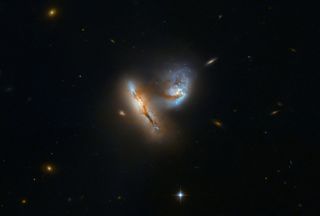
What looks like a delicate dance between two galaxies is actually a slow-motion collision of colossal proportions in this Hubble Space Telescope photo. The two galaxies, called UGC 2369, are merging into one about 424 million light-years from Earth.
(Image credit: ESA/Hubble/NASA/A. Evans)
Two galaxies are caught in a crazy cosmic dance, pulling at each other in a fresh image from a space telescope icon.
Their mutual gravitational attraction is pulling the galaxies closer and closer together in this view from the Hubble Space Telescope released Aug. 13. The slow-motion galaxy collision, which scientists call UGC 2369, is about 424 million light-years away. (A light-year is the distance light travels in a year, roughly 6 trillion miles or 10 million kilometers).
The two collections of stars, gas and dust are so close to each other that a faint bridge of material spans the intergalactic gap. This material came from the "diminishing divide" between the two galaxies, the European Space Agency said in a statement.
Related: When Galaxies Collide: Photos of Great Galactic Crashes
"Interaction with others is a common event in the history of most galaxies," ESA stated. "For larger galaxies like the Milky Way, the majority of these interactions involve significantly smaller so-called dwarf galaxies. But every few billion years, a more momentous event can occur."
Our Milky Way, for example, is on an inevitable collision course with the neighboring behemoth galaxy — Andromeda. Individual star systems like ours will likely be largely undisrupted, but distant observers will see the two galaxies gradually become one in some four billion years. ESA nicknames this new merged galaxy "Milkomeda."
Hubble has captured galaxies all over the sky during its nearly 30 years of operations. Some of its most famous galactic images peer back to a time shortly after the Big Bang that formed our universe some 13.8 billion years ago. The latest image of this type, the Ultra Deep Field, was generated in 2016.
Follow Elizabeth Howell on Twitter @howellspace. Follow us on Twitter @Spacedotcom and on Facebook.
https://www.space.com/colliding-galaxies-cosmic-dance-hubble-photo.html
2019-08-18 12:20:00Z
52780355758650
Tidak ada komentar:
Posting Komentar